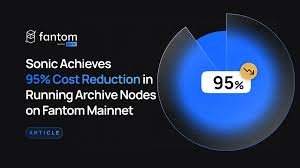Introduction
Blockchain technology has rapidly evolved over the past decade, bringing unprecedented changes to various sectors. From banking and finance to healthcare and supply chain management, blockchain has consistently proven to be a revolutionary force.
But while its promise has always been evident, one of the main limitations hindering its widespread adoption is speed—specifically, the time it takes to finalize transactions on-chain. However, with the introduction of Sonic Blockchain, that limitation may soon be a thing of the past.
During its testnet phase, it achieved an extraordinary 720ms finality time, marking a monumental leap in blockchain technology. This achievement promises to transform how industries and users interact with blockchain systems by improving both speed and efficiency. But what exactly does this development mean for the future of blockchain, and how will it impact the broader tech landscape? Let’s dive deeper.

Sonic Blockchain: A Brief Overview
Sonic Blockchain is a new entrant in the blockchain space, but it’s already making waves with its groundbreaking technology. Designed with scalability, speed, and security in mind, the platform is aimed at overcoming the significant challenges that current blockchain networks face—namely, congestion, latency, and high transaction costs.
Traditional blockchains, such as Bitcoin and Ethereum, often struggle with slow transaction speeds and scalability issues. These inefficiencies have led to rising gas fees and slow finality times, making them less than ideal for certain real-world applications.
However, it has set its sights on resolving these issues. During its testnet phase, the platform achieved an unprecedented finality time of 720ms—a remarkable achievement considering that many of the world’s leading blockchain networks take anywhere from several seconds to several minutes to finalize a transaction. By drastically reducing the time it takes to confirm a transaction, it is positioning itself as a top contender for industries where speed and efficiency are critical.
The Testnet Phase: Pushing the Limits of Speed and Efficiency
The testnet phase is a crucial period in any blockchain’s development, as it allows developers to test the network’s capabilities in a simulated real-world environment. For it , this phase was an opportunity to push the limits of what was possible in terms of transaction speed and finality. While many blockchains focus on optimizing either security or scalability, it has managed to balance all three—speed, security, and scalability—making it a true game changer.
The 720ms finality time is particularly noteworthy because it represents a quantum leap forward in blockchain efficiency. Finality refers to the point at which a transaction is permanently recorded on the blockchain, making it irreversible and immutable. For most blockchain networks, this process takes several seconds or even minutes, depending on network congestion and other factors. Sonic Blockchain’s ability to finalize transactions in just 720ms—less than a second—sets a new standard for blockchain performance.
This testnet phase achievement is not just about breaking speed records. The ability to confirm transactions in near real-time opens up a wide range of use cases for Sonic Blockchain, particularly in industries where milliseconds matter—think of high-frequency trading, IoT devices, or even autonomous vehicles. By achieving this level of speed and efficiency during the testnet phase, Sonic Blockchain has demonstrated its potential to lead the charge in next-generation blockchain applications.
Speed and Efficiency in the World of Blockchain: Why It Matters
Speed and efficiency are two of the most important factors that determine the viability of any blockchain network. Whether it’s processing payments, executing smart contracts, or transferring data, the time it takes to confirm a transaction can make or break a system’s utility. Slow finality times can lead to network congestion, frustrated users, and increased costs—issues that have plagued older blockchain platforms.
it’s breakthrough in achieving a 720ms finality time addresses these problems head-on. With faster transactions, users can enjoy a seamless experience without having to wait for confirmations or deal with high fees due to network congestion.
Moreover, businesses that rely on blockchain for mission-critical applications will benefit greatly from it’s efficiency. For example, in supply chain management, where goods and services need to be tracked in real-time, it’s rapid finality can provide a level of transparency and speed that was previously unattainable.
In the context of decentralized finance (DeFi), where users need to execute trades and manage assets instantaneously, the importance of speed cannot be overstated. By offering near-instantaneous finality, Sonic Blockchain could usher in a new era of decentralized applications that function with the same fluidity as centralized systems, without sacrificing the core principles of decentralization.
Breaking Down the Technology: How Sonic Blockchain Achieves 720ms Finality
So, how exactly does it manage to achieve this unprecedented level of speed and efficiency? The answer lies in its innovative consensus mechanism and architecture.
Unlike traditional blockchains that rely on Proof of Work (PoW) or Proof of Stake (PoS), Sonic Blockchain utilizes a cutting-edge hybrid consensus mechanism known as Dynamic Sharding and Delegated Proof of Authority (DPoA).
This hybrid model allows Sonic Blockchain to process transactions in parallel across multiple shards, effectively reducing the workload on individual nodes. By delegating certain tasks to a trusted set of validators, it can finalize transactions faster without compromising security.
Another key component of Sonic Blockchain’s architecture is its Layer 2 scaling solutions, which work in tandem with the main chain to offload some of the computational work. These solutions ensure that the network can handle high volumes of transactions without slowing down or becoming congested. Together, these innovations make Sonic Blockchain a highly efficient and scalable platform capable of supporting a wide range of applications—from microtransactions to complex smart contracts.
But speed is only one part of the equation. it has also been designed with a high level of security in mind. The platform employs advanced cryptographic techniques to safeguard transactions, ensuring that users’ data remains secure even as the network scales. This combination of speed, efficiency, and security makes it one of the most promising blockchain platforms to emerge in recent years.
Use Cases and Real-World Applications: What the Future Holds
The potential applications for it’s technology are virtually limitless. With its 720ms finality time, the platform is well-suited for industries that require fast and efficient transaction processing. Some of the key areas where it could make a significant impact include:
- Financial Services and DeFi: Sonic Blockchain’s speed and efficiency make it ideal for decentralized finance applications. Instant finality means users can trade, lend, and borrow assets in real-time, without the need to wait for lengthy confirmation times.
- Supply Chain Management: In industries where goods and services need to be tracked and verified at every step of the process, Sonic Blockchain’s rapid finality can provide unparalleled transparency and accuracy.
- Internet of Things (IoT): As the number of connected devices continues to grow, the need for fast and secure data transfer becomes increasingly important. Sonic Blockchain’s architecture allows for real-time data processing, making it an ideal solution for IoT applications.
- Gaming and NFTs: Sonic Blockchain’s fast transaction times can greatly enhance the user experience in blockchain-based gaming and NFT marketplaces. Players can enjoy seamless interactions with in-game assets, while NFT creators can mint and trade tokens with minimal delay.
- High-Frequency Trading: In financial markets, where milliseconds can mean the difference between profit and loss, Sonic Blockchain’s 720ms finality time offers a competitive advantage to traders and institutions that rely on speed for success.
As more industries begin to explore the potential of blockchain technology, Sonic Blockchain’s combination of speed and efficiency will likely position it as a leader in the space.
Conclusion: Sonic Blockchain Sets a New Standard
The blockchain space is constantly evolving, and Sonic Blockchain’s achievement of 720ms finality during its testnet phase marks a major milestone in that evolution. By offering unprecedented speed and efficiency, the platform has the potential to transform industries that rely on fast, secure, and scalable transaction processing. From decentralized finance to supply chain management, Sonic Blockchain’s technology could revolutionize the way businesses and users interact with blockchain systems.
As we look to the future, it’s clear that Sonic Blockchain is not just a fleeting innovation—it’s a game changer that could define the next generation of blockchain technology. With its combination of speed, security, and scalability, Sonic Blockchain is setting a new standard for what blockchain networks can achieve.
What do you think about Sonic Blockchain’s 720ms finality? Could it be the future of blockchain? Let us know your thoughts in the comments below!






